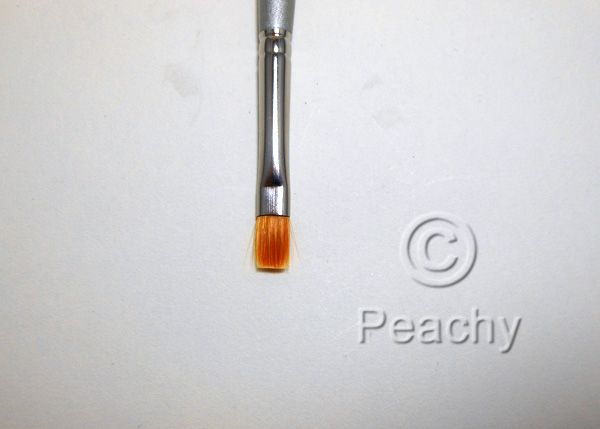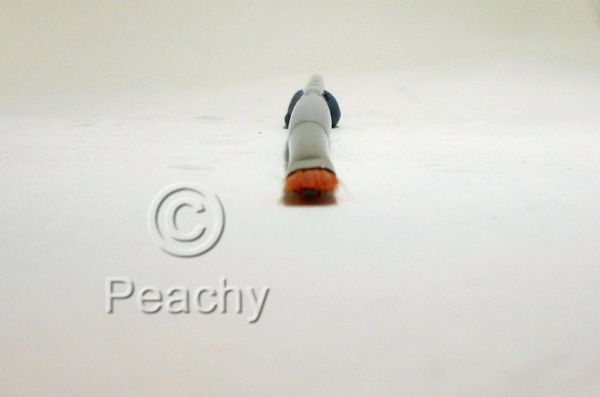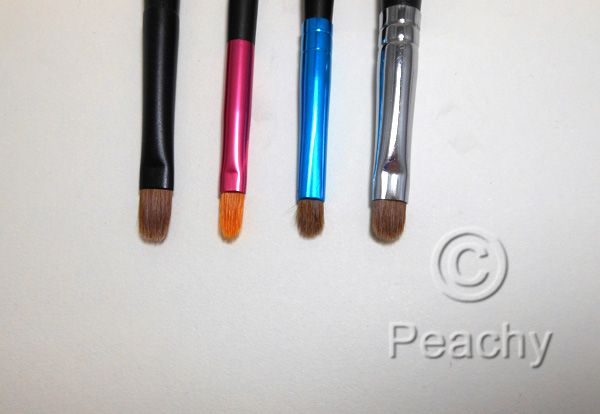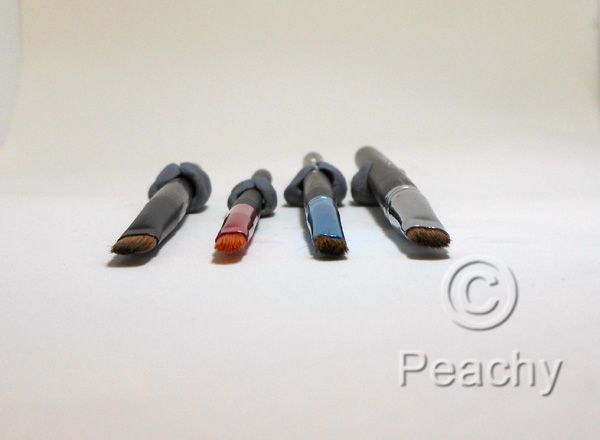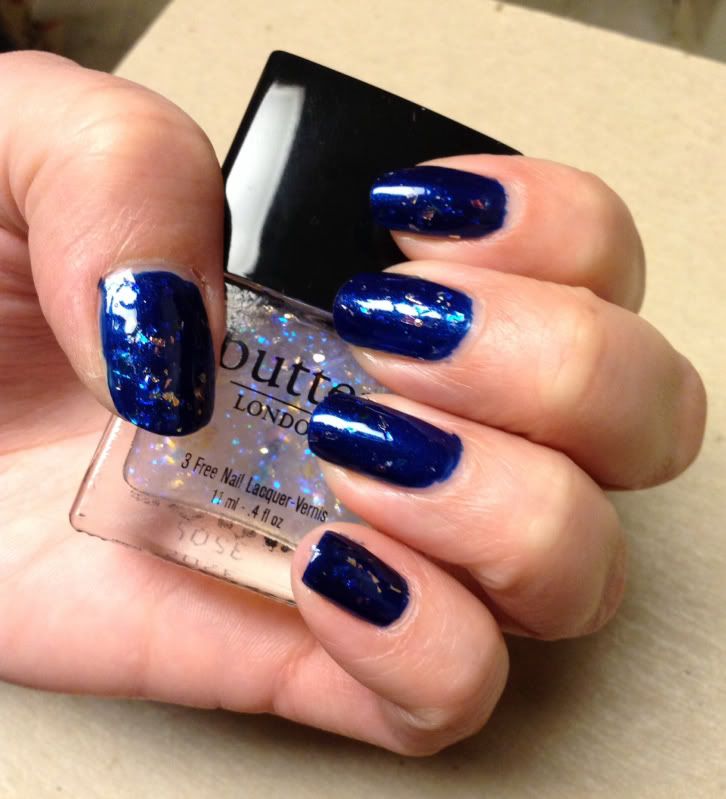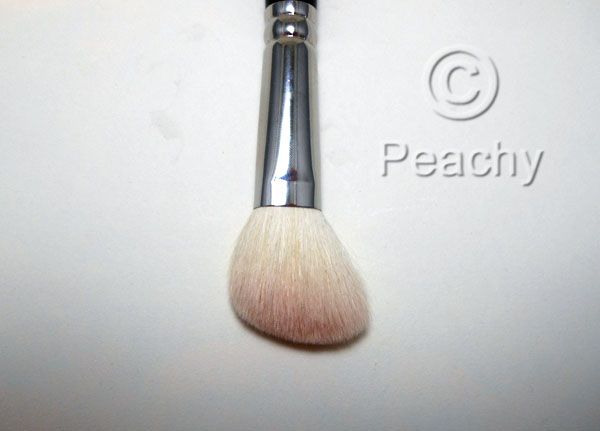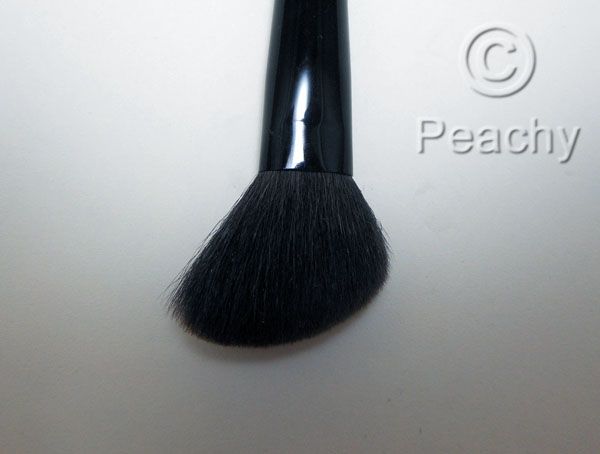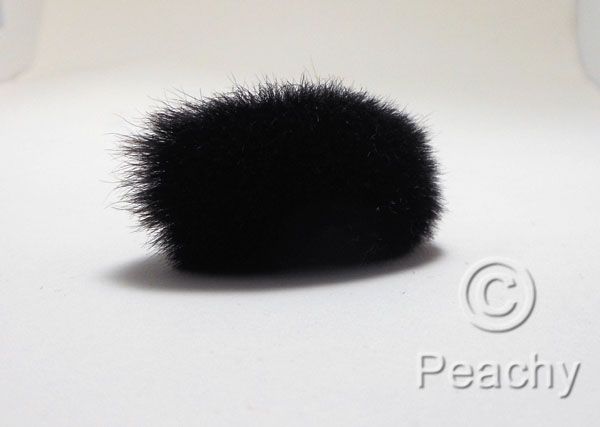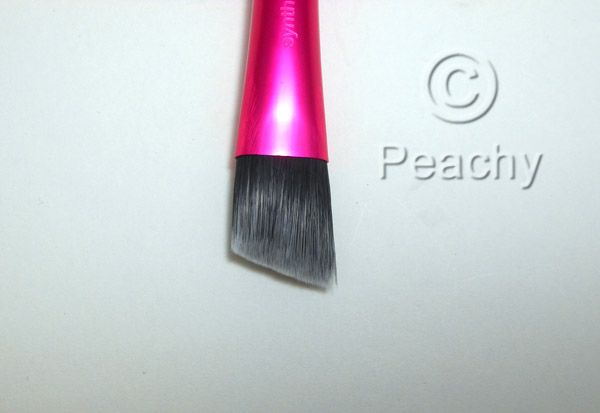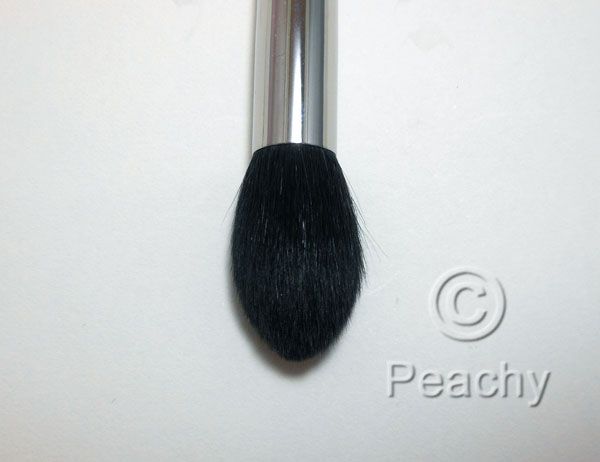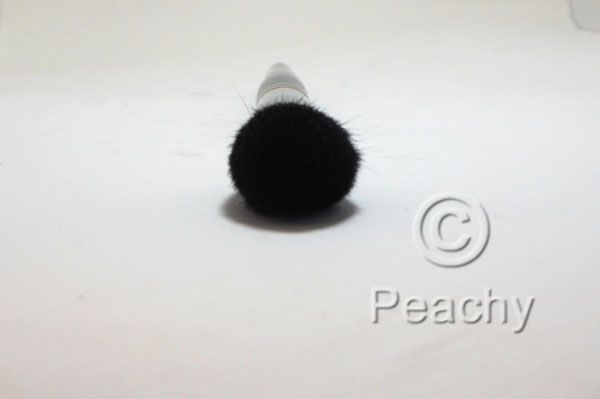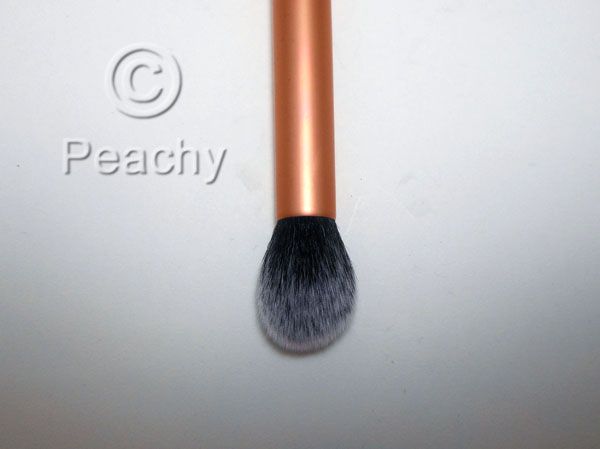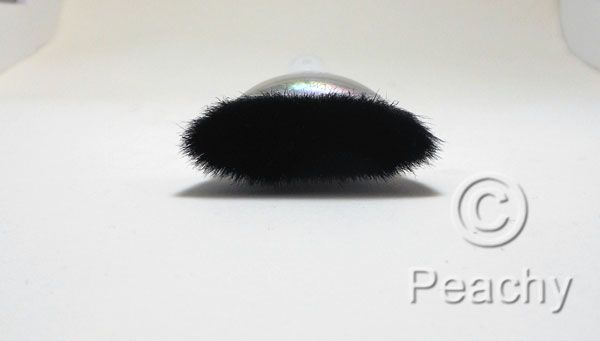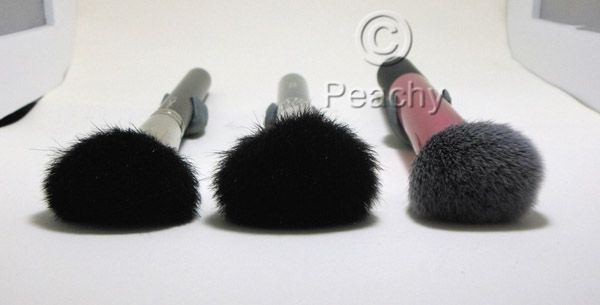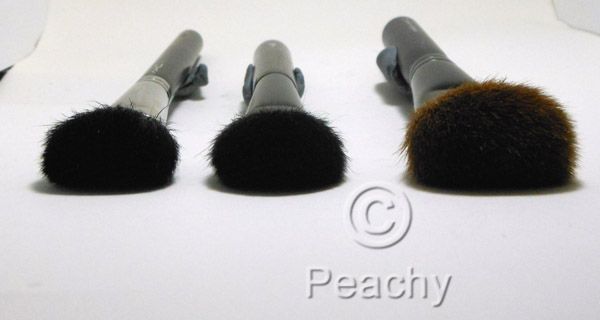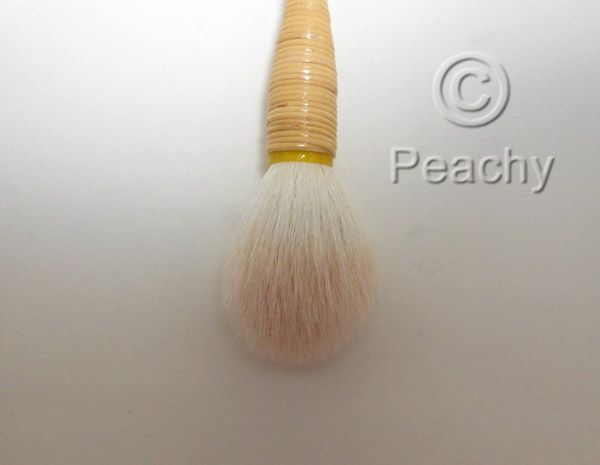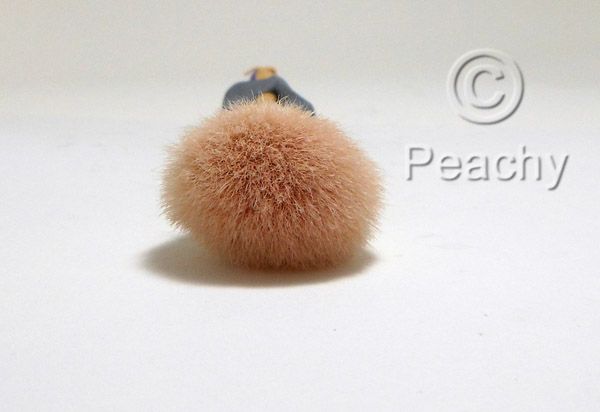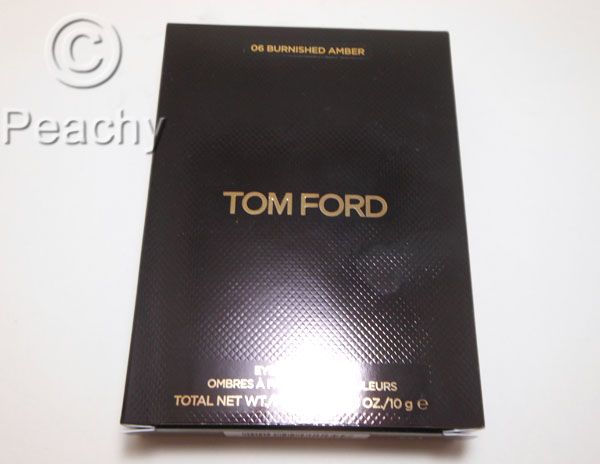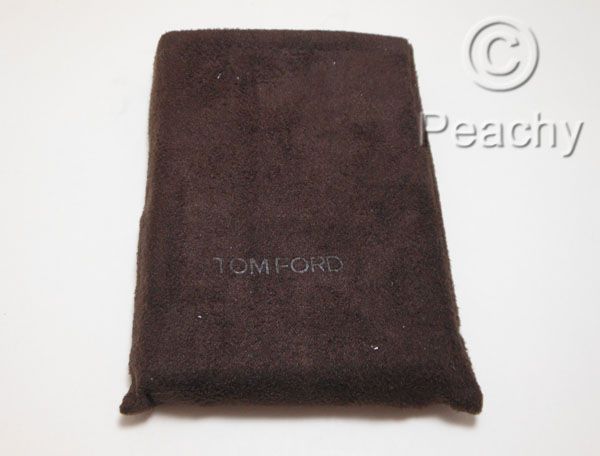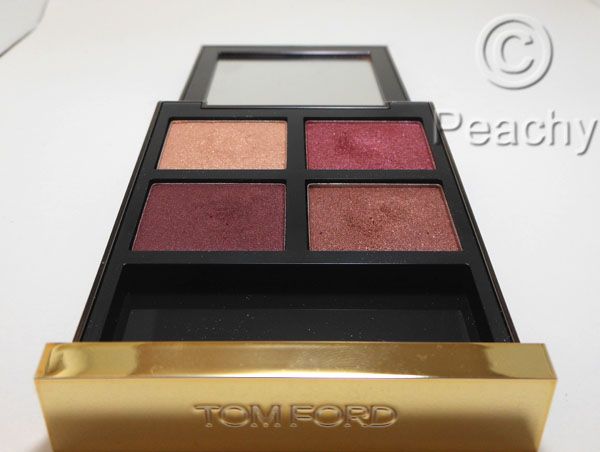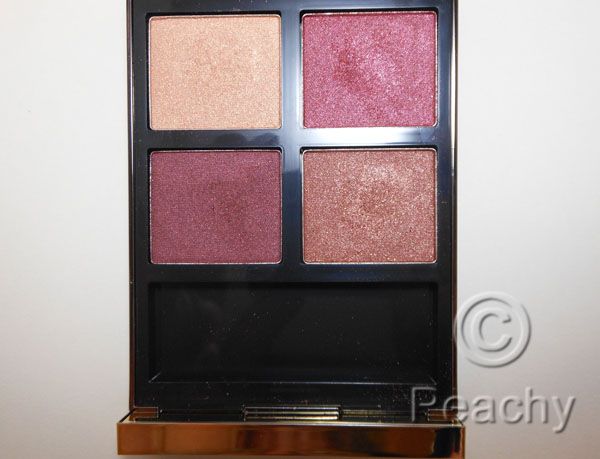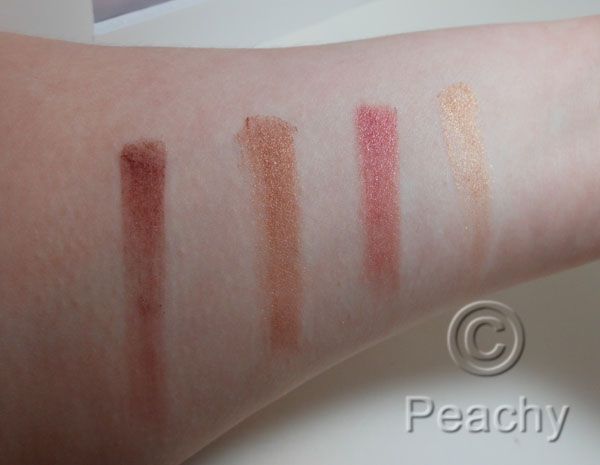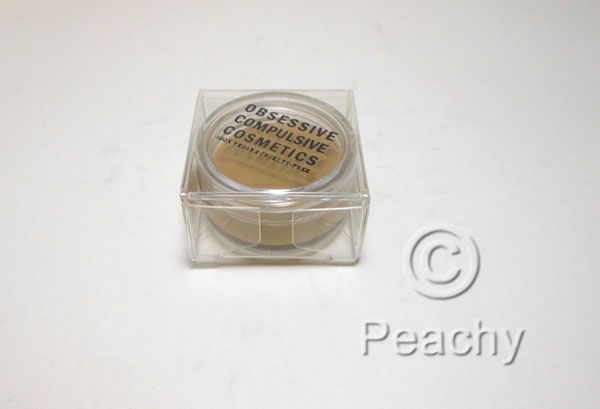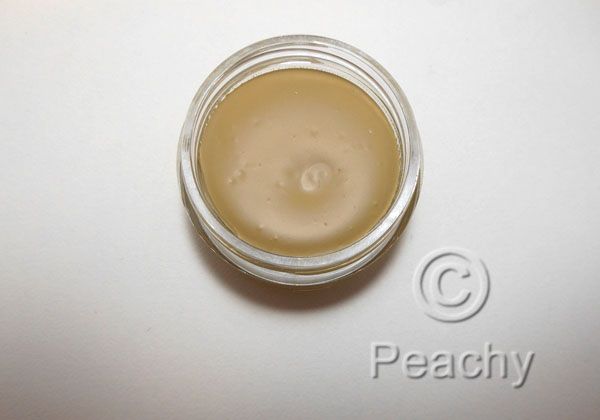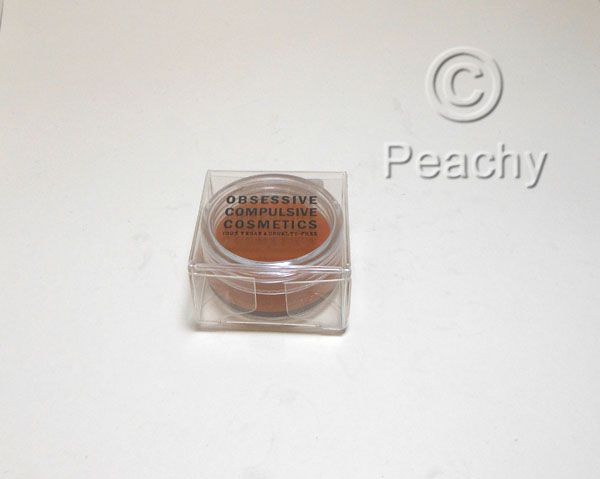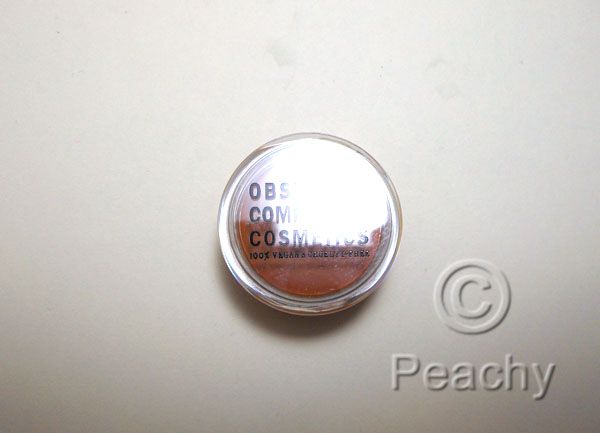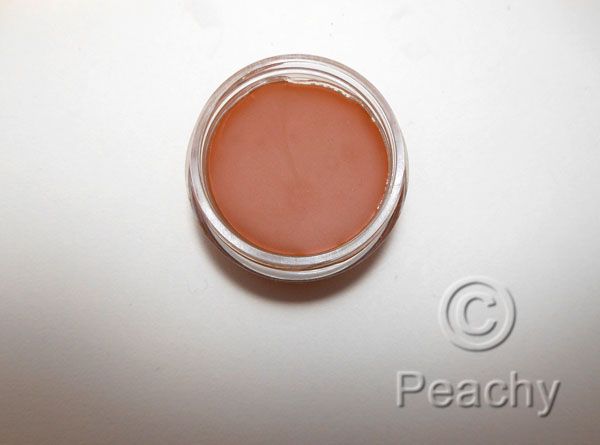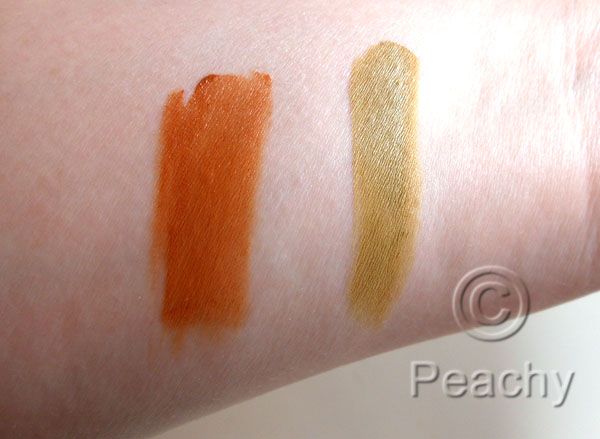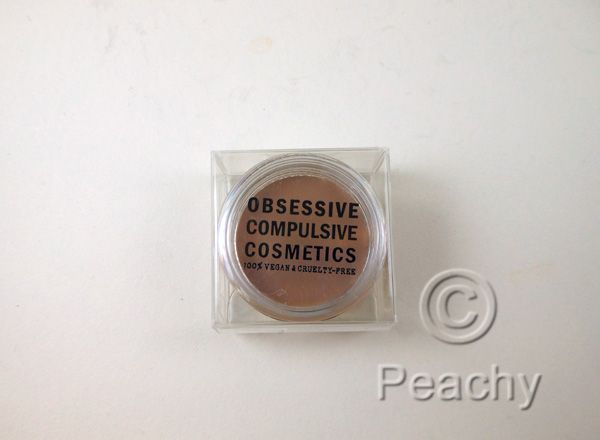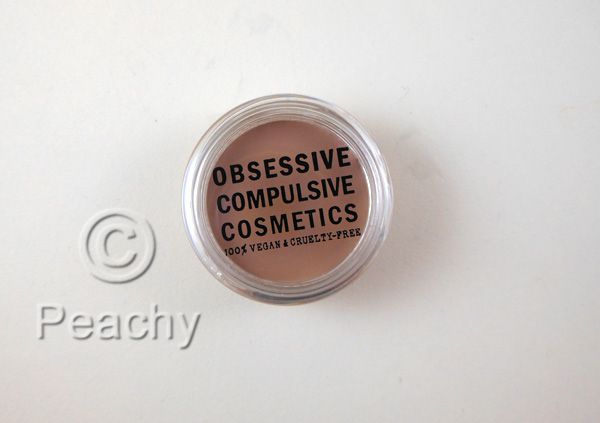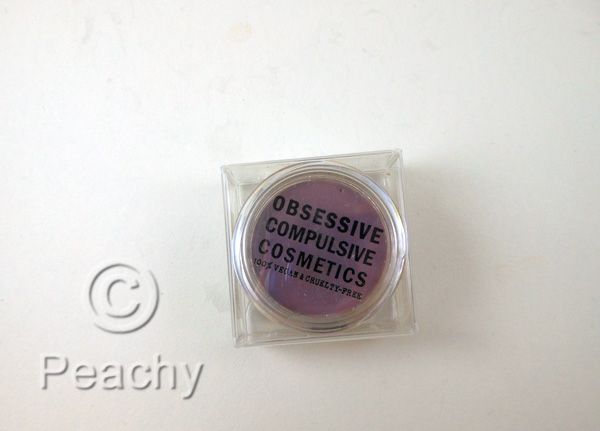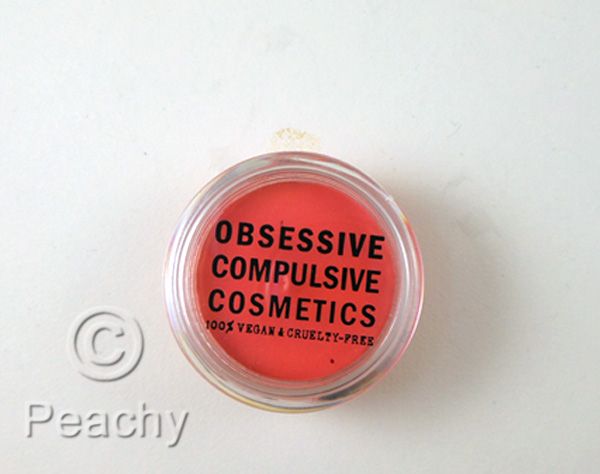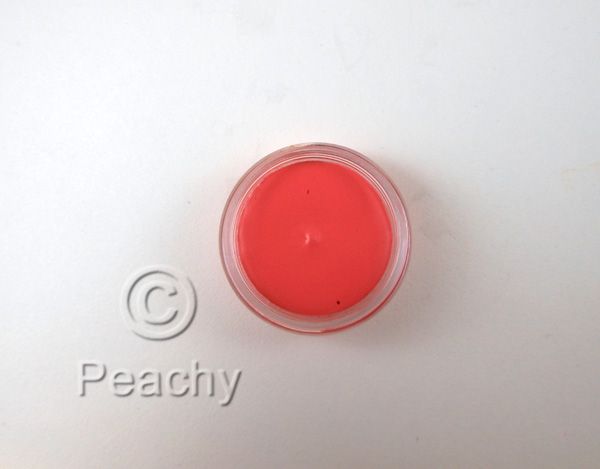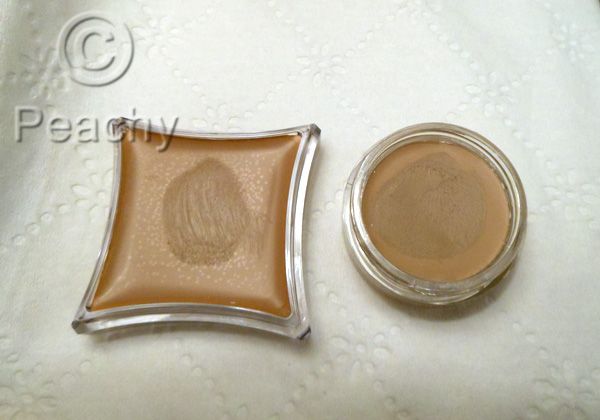Friday, January 29, 2016
Kat Von D Lolita Comparison
From L to R: Lolita Everlasting Liquid Lipstick (from duo), Lolita II Everlasting Liquid Lipstick (from duo), Lolita Studded Kiss Lipstick
Monday, November 4, 2013
A Guide to Brushes: Lip Brushes
And finally we come to the last type of brush I'm featuring: lip brushes. Maybe they're not necessary, but I love lip brushes. I think they blend lipstick much better than applying from the bullet and they give me a finish I personally prefer. So, with no further ado, I present lip brushes.
Square Lip Brushes
This is an old Cargo synthetic lip brush. A square lip brush has a flat end and flat sides and all the bristles are the same length. This makes it a good lip brush for beginners or the less-coordinated, as well as those who want a very defined lip line.
I don't love this style as a blender, however. It isn't great for softening lip liner, or creating an ombre effect, as the blunt end tends to move everything around equally. It's also not the best shape for small lips. It is, however, one of my favorites for applying a dense, opaque layer of lip color, especially a dense matte or a sticky gloss.
Pointed Lip Brush
These pointed lip brushes, one synthetic Japonesque and one "sable" from a beauty supply store. These style brushes are great for lining the lips, either with the lipstick itself, or to blend pencil liner. It's also good for ombre lips. This is a great brush for smaller lips; for medium to large lips, it can create streaks (and takes forever!).
The tapered tip allows for definition, but a bit more softness than the blunt tipped brush above. If you're into very elaborate or detailed lips, then this is a good brush to have. It's also good for something like OCC Lip Tars, where you want precision and a tiny amount of product.
Rounded Lip Brush
The rounded lip brush, here a weasel Hakuhodo, a synthetic Japonesque, and two natural bristled Royal and Langnickels, combines the best features of the two above and is my choice for an all-around lip brush. It's similar in shape to a flat eye shader brush, only smaller, and I've certainly used a small eye shadow brush in a pinch. This brush is good for laying down lip color as well as blending harsh edges. The line isn't as crisp as can be achieved by the two above.
The rounded lip brush works great for creamy lip products, and for working matte lipsticks into the lips, creating a stain (my favorite!). It gives a smooth application, so it's best for finicky products that might streak, like pale colors or very creamy products. The brush on the far left, a Royal and Langnickel Silk lip, is rounder, squatter, and shorter than the rest, making it especially good for applying lip color to very full lips, or to the bottom lip.
Pros and Cons
Pros: Lip brushes make lip colors last longer. They also make them look better (okay, that's just my opinion, but I can hate a lipstick applied from the bullet and love it with a lip brush), and they're a must for intricate looks and finicky products. I love my rounded lip brushes most of all, as they give me control and fewer streaks (especially on my fuller bottom lip), and allow me to work lip colors into the lips for a stained effect.
Cons: Lipsticks can be applied from the bullet, and glosses often come with doe foot applicators and brushes, so a lip brush might not be a top priority. They're one of those things that make your application better, but they're not necessary.
The brushes featured in this post are: Cargo Lip Brush 13 (which appears to be discontinued, though their website describes the covered lip brush as the same), Japonesque No. 802 Lip Brush Travel (which also appears to be discontinued), a brush I've had so long the brand rubbed off, Hakuhodo Kokutan Lip Brush RS, Japonesque lip brush from the Touch up Tube Brush set, Royal and Langnickel Silk Lip Brush, Royal and Langnickel Master Pro Lip Brush. All were purchased and I received no compensation for including them.
Tuesday, October 8, 2013
Butter London Double Take Ice Duo
A quick post to show a recent purchase: Butter London Blue Coat and Leccy.
Blue Coat is a stunning dark blue shimmer, that never looks black. Leccy is a shard "flakie," which makes it a glitter rather than a true Essie Shine of the Times type flakie. It's much finer than China Glaze Luxe and Lush, both in fragment size and in overall feel. Leccy is also a mixture of the warmer red-gold shards and cool blue-green shards, which is unique for a shard. It's really lovely, though does require a few extra coats of top coat.
Also, the guest nails are my sister's beautiful nails.
Blue Coat is a stunning dark blue shimmer, that never looks black. Leccy is a shard "flakie," which makes it a glitter rather than a true Essie Shine of the Times type flakie. It's much finer than China Glaze Luxe and Lush, both in fragment size and in overall feel. Leccy is also a mixture of the warmer red-gold shards and cool blue-green shards, which is unique for a shard. It's really lovely, though does require a few extra coats of top coat.
Also, the guest nails are my sister's beautiful nails.
Friday, August 16, 2013
A Guide to Brushes: Contour Brushes
This post, which could be considered "Blush Brushes: part 2" is about brushes intended for contour and angled blush brushes whether or not they're intended (by manufacturer) for contour.
Angled Blush Brush
This MAC 168, which is white goat, is both a blush brush and a contour brush. Now, I don't favor this sort of brush for cheekbone contour, as I prefer more exactness from my contour brushes. It makes for a good blush brush though, especially if you want to apply blush to the cheekbones. It's also good for facial contouring: around the perimeter of the face, to decrease the width of the face, under the chin, or temples. The white goat of this particular brush is usable for powders, creams, and liquids. It's okay, then, but not great, for cream blush or contour, and it's great for liquid foundation.
Sorry, there's no "cross-section" photo for this brush.
Fluffy Angled Blush Brush
This brush, the Paula Dorf Cheek brush is a fluffier, softer version of the angled brush above. It's intent is to fit over the apple of the cheek, and it's good for that. It's a bit fluffy for placing contour, but it makes for a good blending brush. It's good for applying blush (or contour) to a wide area, so appropriate for larger faces, or when you want a big, child-just-in-from-the-cold, blush.
See how fluffy the hairs are, and how much space between them? This means not too much pigment will be desposited on the cheek, but it will be in a wide area. If that's what you want, this is a good style for that. I have come to prefer smaller blush and contour brushes, so this style has fallen out of use with me.
Angled Synthetic Cream Blush Brush
This Sephora I.T. Cream Blush brush is tight, synthetic, and very flat. It's good for placing cream or liquid blush and contour. It's not great for blending them, unless you're looking for a very controlled blend by fanning out the color. This is a technique often used in stage makeup aging techniques to create a shadow with one soft, blended side and a hard line, for instance, in creating naso-labial folds. You could use this technique to create a very strong, stylized contour. You draw a line of product, then place a flat brush on the line, as if you were drawing the line again and pull away the color to one side. Then this fanned out area is blended traditionally.
This brush type is good for cream blush, great for contour, and isn't a bad liquid or cream foundation brush. While I don't believe it's good for true blending of cheek products (other than the technique described above, which, let's admit, is a pretty specialized technique), it is good for a final blending and working together of already applied and blended cream or liquid products.
Round Contour Brush
I think this brush, here a MAC 109 of goat hair, is what most people picture when I say "contour brush." It bears a close resemblance to foundation buffing brushes, a use for which this particular brush gained a cult following. It also gained a notoriety for shedding. It's good for pretty bold, though not necessarily distinct, cheek contour and is good for under the jaw contouring and around the perimeter of the face.
This brush is also good for the doll cheeked, so-called "pop of color" on the apples look. Can we please all agree to ban the word "pop" from the beauty vocabulary? How about "concentrated placement of a bright color?" "Emphasis through color?" Or the simple and straightforward "accent?" Do you know what I think of when I hear "pop," especially the Yahoo! Answers-esque "How do I make my eyes pop?" From the time I was a little girl to my early twenties, my family and I went on a yearly vacation to a small inn on the Northern Californian coast where there was a big party in the mountains. Freshly caught abalone, tons of wine (not for the kids, of course), fish stew, the cold waters of the Pacific Ocean, the stunning cliffs, the redwoods--the party sucked for this kid, but the scenery was the stuff of magic and mystery. Well, as the abalone divers aged out over the decades, the younger generation took to the water, often bringing along their diving friends (as the legal limit for each diver is very small, the more divers, the more weird, tough, slimy shellfish for breading and frying). Well, one year when I was a teenager, one of those friends had ever-so-slightly more than normal bulging eyes at the party. When prompted, he explained that he had not properly pressurized his mask while diving, and his eyes literally popped out of his head while underwater, and that they hadn't quite normalized yet. (I must put the caveat that I have no idea if this story is true, or even plausible, but it left quite the impression on me, nonetheless) So, uh, yeah...no more popping eyes, okay? Or blush. But that thing we're agreeing to not say anymore?--this brush is good for that.
Pointed Contour Brush
This pointed brush, a Hakuhodo G5521BkSl, blue squirrel and goat, is great for cheekbone contouring and all facial contouring. If the brush is small enough (this is), it could also be used for nose contouring and blending of nose contouring. The pointed tip allows for very careful placement of contour, which results in the ability to carefully sculpt the face. This is one of my favorite shapes for contouring. It's equally good for highlighting all parts of the face.
This brush isn't a great blush brush, however. It applies blush in too concentrated an area even for me. If you want an all around brush for both blush and contour, this isn't likely to be it. However, if you want a great contour brush, this might be the shape for you. The larger of this style, featured in my powder brush post http://bepeachy.blogspot.com/2013/04/a-guide-to-brushes-powder-brushes.html, is another good, one.
Soft Pointed Brush
I had a lot of trouble coming up with a title for this brush example. I toyed with round/pointed brush, but that sounds confusing and nearly lumped it with the pointed brush above. Truth be told, this brush, a Real Techniques synthetic Contour Brush, combines elements of both the round and the pointed brushes. It's wonderfully directional, but it's softly rounded end makes it better for blending and for less distinct contouring under the cheekbones. Because this brush is synthetic, that makes it good for cream blush and contour.
It's also a great blush brush. I've used this brush on a lot of faces for blush, and it's great. If you want an all around blush and contour brush, this is a good (and inexpensive) choice.
Square Contour Brush
This flat, square brush, a Sonia Kashuk Flat Top Sculpting Brush, which is goat, is good for a strong cheek contouring of either powder or cream. If you like to contour with creams under your foundation, a technique used by Wayne Goss on Youtube, and by Scott Barnes, for example, this is a good brush to apply the contour.
This brush is uni-tasker, but it's very good for that one task.
Flat Shading Brush
This Tom Ford Shade and Illuminate Brush, reviewed here: http://bepeachy.blogspot.com/2012/02/tom-ford-shade-and-illuminate-review.html, may be one of a kind in shape. It's like a large synthetic flat shader brush. It's good for cheekbone and temple contouring with cream products.
This brush is also great for highlighter; actually, it's fantastic for cream or liquid highlighter.
Pros and Cons
Pros: Contouring has been gaining popularity in recent years, whether it's the over the top, drag-influenced look of Kim Kardashian and her ilk, or the high fashion look on the runways. While contouring for every day might not be your style, for special occasions or photography, you may want to try it out. These brushes allow for dedicated brushes for this purpose, though some of them double as blush brushes. like the rounded and soft pointed brushes.
Cons: Most of these brushes are unitaskers, and, if you're a brush collector like me, that doesn't matter, but if you want to pare down to as few brushes are possible, you'd probably want a brush that does more than one thing. Especially if you only contour occasionally.
The brushes featured in this post are: MAC 168 Large Angled Contour Brush, Paula Dorf Cheek Brush, Sephora I.T. Cream Blush Brush (discontinued), MAC 109 Small Contour Brush, Hakuhodo G5521BkSl Highlight Brush Pointed, Real Techniques Contour Brush (from the Core Collection), Sonia Kashuk Flat Top Sculpting Brush (discontinued), Tom Ford Shade and Illuminate Brush. All brushes featured in this post were purchased and I received no compensation for featuring them.
Wednesday, July 24, 2013
A Guide to Brushes: Blush Brushes
Blush brushes are, without a doubt, the most important and useful brushes a makeup lover can own. Okay, maybe I'm biased as a devoted blush lover, but really, aside from the teenager I witnessed applying blush by rubbing the product directly on her cheek, powder blush is really difficult to apply and blend without a good brush. So, read on to help you find one.
Classic Blush Brush
MAC 129, goat, Dior Blush Brush, Real Techniques Multi-Purpose Brush, synthetic
Dense and fluffy, I refer to these brushes as classic for a reason. They are sized to apply blush over the apples of the cheeks in a classic fashion. They're great for medium pigmented blushes when you want to apply over a large area on your cheeks. They have pinched ferrules, but they tend to have a lot of bristles and they fluff out a lot. This makes them pretty good blenders and good for bronzer, if you wear it.
For highlighting or contouring (which will be the next post in this series), this would not be directional enough to place the color precisely. Similarly, they are not good for applying color to the cheekbones only. The fluffy bristles are not well suited to either densely pigmented blushes or sheer blushes, as the former would end up with too much color on the cheek, and the latter would mean little color was applied to the cheek.
Small Blush Brush
MAC 116, goat, Hakuhodo Kokutan Blush S, blue squirrel/synthetic, and Sephora Classic Complexion 53
The less fluffy and smaller little sister of the classic blush brush, these brushes also have a pinched ferrule. They do not splay or fluff as much as the classic blush, however, and this makes them better for applying blush to a smaller area. You can still use these for the apples, but they also make for fine contour and highlight brushes, and are great for applying blush to the cheekbone area.
Perhaps more than any other brush, the hair fibre will make a big difference in the performance of the brush. The goat MAC116 and the blue squirrel/synthetic Hakuhodo Kokutan Blush S will apply a different level of pigment to the skin. The softer hair is therefore better for more pigmented blushes when you want a lighter touch with them. No matter what hair you choose, this is my favorite blush brush for all around blush application. They make it easy to build up color in layers and apply a variety of products easily.
Flat, Round Blush Brush
Trish McEvoy Sheer Blush 2B
Featuring a very pinched ferrule, this blush brush is like a larger flat shader brush. Instead of using the tip of the brush in circular motion, this brush is great for patting on blush. That makes it great for a (forgive me for using this cliched term) pop of color on the apples of the cheeks. This is also one of my favorite powder contour brushes because the patting motion allows for dense application in some places and lighter application elsewhere--instant blending.
This is not a blending brush, however, and works best with sheer to medium pigmented blushes. I don't often use this for blush application.
Yachiyo Brush
Hakuhodo large pointed yachiyo, goat
This is supposedly a traditional Japanese brush; I can't vouch for that since I know nothing about Japanese traditions outside of woodblock prints in an art appreciation class in college. It's certainly traditional looking, with its cane wrapped handle and lack of a visible ferrule (though I imagine there's one under all that cane). This is one of my favorite blush brushes. I like it for sheer blushes, but I also find the dense, stiff hairs great for getting a small amount of a denser colored blush, too.
Yachiyos also come in less pointed versions (called "purple" by Hakuhodo. I don't know why.), but they all share a round "ferrule." They are great for contouring, especially the pointed version, which fits nicely under the cheekbone and jawline. Another great all around blush brush.
Pros: You need a blush brush; don't even try to argue with me. If you are not already wearing so much blush your neighbors think you may be an 18th century French prostitute, get yourself one of these brushes and one of the beautiful powder brushes from a brand like Tarte, Illamasqua, Chanel, Burberry, or any of the other brands that make awesome blushes, and fix that because blush is life and life is blush. Er...what I really meant to say was big fluffy classic blush brushes are good for apples of the cheek and medium pigmented blush, small blush brushes are good for all around blush application and any sort of blush, flat, round blush brushes are good for sheer application, contour, and bright colors on the apples, and yachiyos are good for getting the most out of sheer or dark blushes and contour. And they can all be used to apply powder, too.
Cons: Repeat after me, there are no cons to blush. The classic blush brush is probably too big for most people's faces. And I guess you don't need a powder blush brush for cream blush. I tend to use stippling/duo fibre brushes for that. If you were to want more information on that subject, see my ground-breaking stippling brush post here: http://bepeachy.blogspot.com/2012/12/a-guide-to-brushes-stipplingduo-fibre.html.
The brushes featured in this post are: MAC 129 Powder/Blush Brush, Dior Blush Brush (this is pretty old, the handle is different and the name has changed, so I have no idea how the cheek brush currently in their line compares to this one), Real Techniques Multi-Purpose brush (from Travel Essential set), MAC 116 Blush Brush, Hakuhodo Kokutan Blush S, Sephora Classic Complexion 53, Trish McEvoy Sheer Blush 2B, Hakuhodo Large Pointed Yachiyo. All were purchased by me and I receive no compensation for featuring them.
Monday, July 22, 2013
Tom Ford Eye Color Quad Burnished Amber--Review and Swatches
Tom Ford Burnished Amber is my second Tom ford Eye Color Quad. I know that these eyeshadows have recieved some criticism for their price, as well as the glitteriness and/or shimmeriness of a lot of the shades, but I think this quad is pretty flawless. For one thing, none of these eye shadows are the sheer glitter-infused texture some don't like. There are, instead, three shimmery shades and one satin. One thing that has impressed me about both the quads I have is the color combinations, which are perfectly coordinated.
The packaging is, of course, exactly what you would expect for the price, sleek and luxurious. I love the softness of the sleeve and it's good for polishing off fingerprints. It also has a nice, big mirror, which is nice.
The colors are absolutely perfect together, though unconventional.
The lightest color is a pale, warm gold with a very shimmery finish. It's too dark for a highlight on lighter skins, but would be lovely on darker skins. I use it primarily to blend out the darker bronze color.
The next color is a deep magenta-tinged pink with a shimmer finish. It's a very rich pink with a good balance of warm and cool tones. I think even if you don't think you suit pink tones, you'd find this color flattering.
The next darkest color is a golden bronze with a shimmer finish. Again, it's not overly warm nor cool.
The darkest color is a dark bordeaux with a satin finish.
The four colors can be used to make a golden look, a pink look, or all four together make a rosy bronze look. The versatility of this palette is one of its best traits. The pink-bronze tones make it very flattering to green eyes, which is one of the reasons I love it. It also suits anyone who looks good in jewel tones, as the richness of the tones would be very flattering.
I have heard rumors that this was being discontinued. It's still in stock as of this post at Neiman Marcus and Bergdorf Goodman online, and I heard this rumor months ago, so I don't know.
OCC Creme Colour Concentrate Review and Swatches
Obsessive Compulsive Cosmetics is a brand I've grown very fond of lately. Their most well known product is, of course, their lip tars, which are mixable, opaque liquid lip colors that come in unique colors. Now, OCC has an intense cream product that's suitable for use on eyes, lips, and cheeks. I bought two of them, Cthulu, a pea green, and Terra Firma, an orangy brown, and fell so desperately in love, I purchased three more, Miriam, John Doe, and Grandma.
The texture of these products is similar to a dense, matte lipstick, and bear resemblance to the Illamasqua cream pigments. One of the benefits of these is that they are safe for eyes and lips, and they don't crease as badly as the Illamasqua product when used on the eyes (and please note, I am very prone to creasing), though, being cream products, they are prone to creasing. Topping with a powder shadow or a loose powder will ameliorate that problem. On cheeks, they're slightly dry, but blendable. They'd do best either blended onto an emollient base or tapped lightly. On lips, they are a satin-matte finish, and are quite comfortable to wear.
What I love most about these are the nuanced and unusual colors, something anyone who's used a Lip Tar has come to expect from OCC.
Cthulu is described as a dirty, pale olive. It is a light pea green shade, with subtle gray and brown undertones. It's reminiscent of a 70's avocado colored refrigerator, only lighter.
Terra Firma is described as burnt sienna brown. It's a russet orange-brown shade that would work well on eyes, lips, cheeks, and, while an unusual color, I still think a lot of people would be comfortable wearing it.
John Doe is described as pale, ash-toned taupe. It's a very light beige-taupe with strong gray undertones and a hint of yellow. It's very cool and light, and makes for an excellent cream contour problem on fair skins. Compared to Illamasqua Hollow, it is cooler and very slightly lighter.
Miriam is described as a subdued, whitened plum. It is a grayed light purple, leaning mauve, with a bit of pinky warmth. It's an unusual, but not necessarily unflattering, lip and cheek color.
Grandma is described as a clean, classic coral. It's very similar to the lip tar of the same name, and is a very bright coral with a good balance of bright pink and orange undertones. To my eye, it leans slightly toward orange, though that would change depending on skin tone and natural lip color.
Cthulu
Terra Firma
Swatches of Terra Firma (l) and Cthulu (r)
John Doe
Miriam
Grandma
Swatches of (from top to bottom) John Doe, Miriam, and Grandma. Grandma appears slightly redder than in real life.
Comparison of Illamasqua Hollow Cream Pigment and John Doe
Swatches of John Doe (left) and Illamasqua Hollow (right). Sorry I switched them.
As you can see, Hollow is warmer than the ashier John Doe.
Subscribe to:
Posts (Atom)


